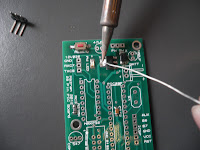Day 1 (5 JULY 2012)
Assalamualaikum
and Salam Sejahtera....
First of all, I would like to thank a lot to Mr. Siva and Mr.
Mazran because have been willing to give me an opportunity to complete my
industrial training period that remaining at 8 weeks at HIIS (Hitech Integrated
Innovation Solution Sdn.Bhd) or known as UTeM Holdings after I had to change the location of
industrial training because of a few problem in the previous company.
After submitting
a letter of resignation to the Ranger Communication on Wednesday, I had to
report to Mr. Mazran on Thursday. After thinking carefully and make comparison
with previous company, I am pretty sure that I can get many benefit and learn
more from this company.
After complete
registration process and get a simple briefing from Mr. Mazran, we have been instructed
to setup a workplace that we will use as our training room during the training
industry. We have chose as a tutorial rooms as our workstation and we have
prepared all the equipment such as desks, fans and soldering equipment.
After that, I
was briefed by Mr. Siva a little bit about electronic components. Mr. Siva said
that as a engineer, we should be very familiar with electronic compenent. He
also emphasized the importance of basic
knowledge of electronics .
There are two categories of electronic components:
i- Surface Mount
Devices (SMD)
ii-Through-Hole
Technology
Surface Mount
Devices (SMD)
Surface-mount technology (SMT) is a method for constructing electronic circuits in which the components are mounted directly onto the surface of printed circuit boards (PCBs). An electronic device so made is called a surface-mount device (SMD). SMDs have improved performance over through-hole components due to their smaller size, shorter internal leads, and smaller board layouts. These factors reduce the circuit’s parasitic inductance and capacitance. SMDs can also be more cost effective than traditional through-hole components due to the smaller board size, fewer board layers, and fewer holes. SMDs can also be easier to replace than through-hole components on multilayer boards.
Example of SMD components
Through-Hole
Technology
A through-hole technology are refers to the mounting scheme used for electronic components that involves the use of leads on the components that are inserted into holes drilled in printed circuit boards (PCB) and soldered to pads on the opposite side either by manual assembly by hand placement or by the use of automated insertion mount machines.
Example of Through Hole component

















